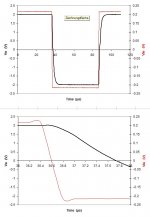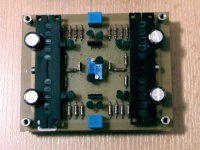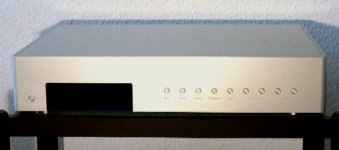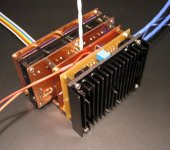Of course I am, as I am always interested in other people´s input.
🙂
In fact you can change my circuit a little bit to avoid loop feedback.
There are different ways to design a single gainstage to a certain
amount of gain. One is to degenerate gain by using source
resistors in a diff stage. Another possibility would be to feed back
the drain node to the gate as I did. Both methods use negative
feedback. The "purist" approach would be not to pick up the
feedback from the joint of the source followers output nodes but
put in two equal resistors in series between the gates of the
followers and use the connection between them as feedback
node. This would be a non overall feedback circuit too AND
you are able to take advantage of X "feedback".
Uli



🙂
In fact you can change my circuit a little bit to avoid loop feedback.
There are different ways to design a single gainstage to a certain
amount of gain. One is to degenerate gain by using source
resistors in a diff stage. Another possibility would be to feed back
the drain node to the gate as I did. Both methods use negative
feedback. The "purist" approach would be not to pick up the
feedback from the joint of the source followers output nodes but
put in two equal resistors in series between the gates of the
followers and use the connection between them as feedback
node. This would be a non overall feedback circuit too AND
you are able to take advantage of X "feedback".
Uli



Hi Uli, it will be clearer with a schematic, your design has some similarities with the Blowtorch and it could be interesting to discuss them, as well as the differences.
> Patrick, maybe could you post it here and we could discuss it, eventually with Uli, of course if he is interested.
I have been reluctant to do so, as a respect to John, as the design discussed here is two stage folded cascode, which is different. And I find the latter more interesting as a circuit topology. The circuit I built is essentially a Borbely EB116, with feedback removed.
> There are different ways to design a single gainstage to a certain amount of gain. One is to degenerate gain by using source
resistors in a diff stage.
Yes, I used source degeneration for both first and second stage, both with JFET cascodes. This is especially necessary for the first stage to give decent bandwidth as I am using 10k gate resistors. Total gain is 20, split as 5 x 4.
Because of source degeneration, I have to use extra CCS for each half of the first stage, as Grey has described in the other post. So that is why I have been quiet up till now. No new inventions. : )
Output (3rd) stage is the Curl complementary JFET follower using 5 pairs of 2SK170V/2SJ74V with 70mA total bias at Idss. I would love to try a MOSFET version as it would be easy to increase bias / voltage / bandwidth with MOSFETs. This is also why I was asking for a MOSFET version of the follower earlier (Post #779). But no one else came up with something different; so either I was on the spot, or totally silly.
Bandwidth is around 105kHz with the 10k input resistors. But as soon as you shunt (for attentation) across the two, you get 350kHz easy. (Proven on the scope).
I shall try to post a schematics and some pictures, and oscilloscope plots later.
Patrick
I have been reluctant to do so, as a respect to John, as the design discussed here is two stage folded cascode, which is different. And I find the latter more interesting as a circuit topology. The circuit I built is essentially a Borbely EB116, with feedback removed.
> There are different ways to design a single gainstage to a certain amount of gain. One is to degenerate gain by using source
resistors in a diff stage.
Yes, I used source degeneration for both first and second stage, both with JFET cascodes. This is especially necessary for the first stage to give decent bandwidth as I am using 10k gate resistors. Total gain is 20, split as 5 x 4.
Because of source degeneration, I have to use extra CCS for each half of the first stage, as Grey has described in the other post. So that is why I have been quiet up till now. No new inventions. : )
Output (3rd) stage is the Curl complementary JFET follower using 5 pairs of 2SK170V/2SJ74V with 70mA total bias at Idss. I would love to try a MOSFET version as it would be easy to increase bias / voltage / bandwidth with MOSFETs. This is also why I was asking for a MOSFET version of the follower earlier (Post #779). But no one else came up with something different; so either I was on the spot, or totally silly.
Bandwidth is around 105kHz with the 10k input resistors. But as soon as you shunt (for attentation) across the two, you get 350kHz easy. (Proven on the scope).
I shall try to post a schematics and some pictures, and oscilloscope plots later.
Patrick
definition
I would define a folded cascode as a single gain stage 😉
The Borbely EB116 is rather a classic 3 stage design with non
diff input stage, Vas stage and output follower.
To avoid the 2nd stage I used a folded cascode (see Pass A75)
to be able to connect a follower directly.
Of course the follower can be left out. The drawback would be
that the gain of this circuit depends heavily on output load.
With BL devices the needed outputload (= drain resistor) would
be around 1k, assuming the degeneration resistors are small
enough to couple the complementary stages together. This leads
to an inapropriate maximum output swing with a given bias of
about 5mA.
Uli



I would define a folded cascode as a single gain stage 😉
The Borbely EB116 is rather a classic 3 stage design with non
diff input stage, Vas stage and output follower.
To avoid the 2nd stage I used a folded cascode (see Pass A75)
to be able to connect a follower directly.
Of course the follower can be left out. The drawback would be
that the gain of this circuit depends heavily on output load.
With BL devices the needed outputload (= drain resistor) would
be around 1k, assuming the degeneration resistors are small
enough to couple the complementary stages together. This leads
to an inapropriate maximum output swing with a given bias of
about 5mA.
Uli



For what is this " exercise quadrat ", guys ? " Deadline judge " is human listening, so what are results ? What's are differences between particular solutions ?  No " hifi newspeak ", please....
No " hifi newspeak ", please....
 No " hifi newspeak ", please....
No " hifi newspeak ", please....Upupa Epops said:For what is this " exercise quadrat ", guys ? " Deadline judge " is human listening, so what are results ? What's are differences between particular solutions ?No " hifi newspeak ", please....
Thanks for the "correction"!

Long live free speech!
Uli



As nobody knows the Blowtorch Design exactly (except of course
John Curl himself ) I don´t know how close anybody in
) I don´t know how close anybody in
this thread is to the original. This is not the point IMHO, guessing
solutions of famous designers is kind of sports😉
Uli



John Curl himself
 ) I don´t know how close anybody in
) I don´t know how close anybody in this thread is to the original. This is not the point IMHO, guessing
solutions of famous designers is kind of sports😉
Uli



Wow, your boards look fine!
Did you ever do a comparison soundwise to the original EB116?
Uli



Did you ever do a comparison soundwise to the original EB116?
Uli



> Wow, your boards look fine!
To give you another temptation (picture).
> Did you ever do a comparison soundwise to the original EB116
a) I never built the original EB circuit.
b) It is not yet finished (remote control); and I have all the patience in the world. So no listening tests as yet.
I am sure someone else might even beat me to First Sound.
Richard ?
: )
Patrick
To give you another temptation (picture).
> Did you ever do a comparison soundwise to the original EB116
a) I never built the original EB circuit.
b) It is not yet finished (remote control); and I have all the patience in the world. So no listening tests as yet.
I am sure someone else might even beat me to First Sound.
Richard ?
: )
Patrick
Attachments
Just an additional remark :
At hindsight, I would probably reduce resistor values and bias the first stage also at say 8mA. The Dual FETs should cope without problems, and they operate then in the more linear region.
And I do not entirely agree with Uli that folded cascode is one gain stage. But then it is a matter of opinion, and we do not have to agree.
: )
Patrick
At hindsight, I would probably reduce resistor values and bias the first stage also at say 8mA. The Dual FETs should cope without problems, and they operate then in the more linear region.
And I do not entirely agree with Uli that folded cascode is one gain stage. But then it is a matter of opinion, and we do not have to agree.
: )
Patrick
Hello, EUVL
Very impressive work indeed... Congrats !
I love your paralleled Jfets heatsink... And I also think that it was home made... BTW I had a similar but simpler work I stopped because of heatsink unavailability (50 paralleled !!!).
The idea was borrowed from an Italian amp that used over 100 small TO92 transistors to run a low power amp... But still curious on how you made it (drill + halfmoon grinding ?).
Anyway, thanks for sharing good pics !
Jbaudiophile 😀
Very impressive work indeed... Congrats !
I love your paralleled Jfets heatsink... And I also think that it was home made... BTW I had a similar but simpler work I stopped because of heatsink unavailability (50 paralleled !!!).
The idea was borrowed from an Italian amp that used over 100 small TO92 transistors to run a low power amp... But still curious on how you made it (drill + halfmoon grinding ?).
Anyway, thanks for sharing good pics !
Jbaudiophile 😀
> I love your paralleled Jfets heatsink
Only heat distributor. The heatsink is over the entire board and also contact the test of the TO92 transistors on the top surface.
They are manufactured using CNC wire-cut EDM, then black anodised. I have access to a very well equipped industrial workshop.
Patrick
Only heat distributor. The heatsink is over the entire board and also contact the test of the TO92 transistors on the top surface.
They are manufactured using CNC wire-cut EDM, then black anodised. I have access to a very well equipped industrial workshop.
Patrick
Attachments
- Status
- Not open for further replies.
- Home
- Amplifiers
- Solid State
- John Curl's Blowtorch preamplifier




